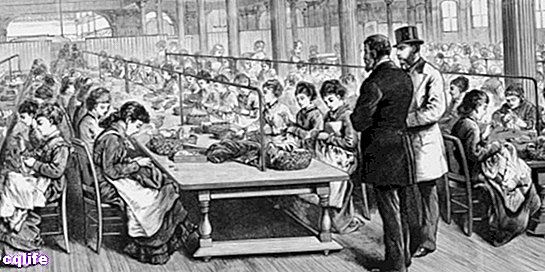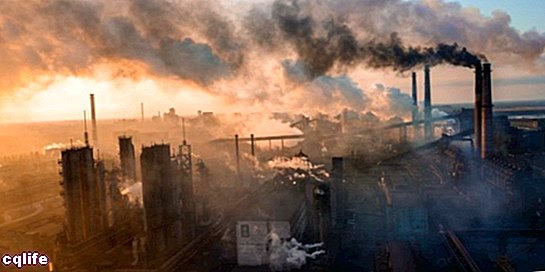- What is capitalism?
- Characteristics of capitalism
- Origin and history of capitalism
- Criticism of capitalism
- Capitalism, socialism and communism
We explain what capitalism is, its history, characteristics and why it is criticized. Also differences with socialism or communism.

What is capitalism?
Capitalism is the prevailing socio-economic system in the West after the fall of the feudalism medieval, and dominant throughout the world today in the 21st century. It is a system of the societies bourgeois industrialists.
Its two main and defining features are: private property of the means of production and free economic exercise. Its name comes from the idea of capital, that is, of the central role of money in the relations of production and consumption.
Capitalism proposes that money marks the measure of the exchange of goods and services, and that it is obtained in different ways:
- As compensation for work, in the case of workers.
- From income, in the case of owners.
- As a result of risk and the investment, in the case of businessmen or entrepreneurs.
For all this to be possible, it is necessary that private property exists, and that the productive and commercial exercise be free, that is, that each person invest in whatever they want and reap the fruits or losses that the market throws at them.
In capitalist societies, therefore, the relations of production and labor, and of consumption of goods and services, are determined respectively by a wage system and a price system. In this way, individuals consume what the amount of money they produce allows them.
The entire society works, then, seeking to obtain a benefit, that is, an economic income greater than expenses, which allows a surplus of capital (with which to consume, invest or save).
Central in capitalism is the "self-regulation" of the market that marks the relationship between offer and the demand: the products The most demanded (and therefore more scarce) become more expensive, while the least demanded (and therefore more abundant) become cheaper. This idea is the subject of much debate. It is often known as the "invisible hand" of the market.
Characteristics of capitalism
Capitalism can be characterized as follows:
- It proposes capital as a measure of economic relationship, and its obtaining through economic freedom and the exploitation of private property. For this, it is essential that the latter be allowed and protected by the Condition.
- Capitalism is the economic system proper to industrial and bourgeois societies, and its appearance marked the end of feudalism. The bourgeoisie (the merchants and later industrialists) displaced the aristocracy (landowners of noble descent) as the social class dominant.
- It is based on the idea of supply and demand: goods and services are demanded by their consuming public, and offered by their producers. Depending on how this relationship occurs, the products will be more or less expensive and more or less abundant.
- As a system, capitalism promotes competence and rewards risk, entrepreneurship and innovation, which in the twentieth century was translated into unbridled technological development. At the same time, it allows and rewards speculation and usury, allowing the generation of gain from debt, interest and other unproductive activities.
There are or have been different models of the capitalist system, such as:
- Protectionism. According to which the State sets tariffs and regulations to artificially increase the price of products from abroad, and thus protect its industry and promote the consumption of national goods and services.
- Laissez-faire (from the French "let go"). That limits the interference of the State to the maximum and allows the greatest share of freedoms to the market, without regulations of any kind.
- Social market economy. Completely contrary to the previous one, it states that the financial year must be guided and planned by the State, without reaching the extreme of suffocating fundamental economic freedoms.
- Corporate capitalism. In which the market is dominated by hierarchical corporations and large economic groups that exercise power and determine the market.
On the other hand, capitalism builds a society divided into social classes according to their economic income and possession of capital (or property). These social classes are, according to the look Marxist of capitalism:
- The bourgeoisie and high bourgeoisie. Owner of the means of production (factories, shops, etc.), or of large investment capital.
- The working class. Whose participation in society is to sell their work capacity, be it qualified (professionals, technicians) or not (workers).
- The lumpen. The unproductive sector of society.
Origin and history of capitalism

Capitalism has not always operated in the same way that it does today. Although its formal beginnings date from the 16th and 17th centuries, there were important antecedents at various times and places in the history.
Its most direct antecedent is located towards the end of the Middle Ages, as a new dominant social class emerged from feudal society: the bourgeoisie, whose commercial activity allowed the accumulation of money or other assets (merchandise, and later machinery), which is a fundamental feature for the emergence of capitalist logic .
The origin of capitalism was strongly determined by the expansion of the textile industry English from the seventeenth century, thanks to the overcrowding of work. In the 18th century, with the first artisan machines, the industrial mode of production began.
The rise of the first States-nation and the Industrial Revolution were key elements in the establishment in Europe of the new system.
The spirit of classical capitalism of the time was understood by the Scottish economist and philosopher Adam Smith (1723-1790). It was embodied in his The Wealth of Nations , from where the central foundation of the free market, which advised the least possible interference by the State.
His ideas were later part of the philosophy of Liberalism of the 19th century, a time that witnessed the development of the factory system, and the gigantic exodus from rural to urban regions that it caused, thus giving rise to the working class or proletariat.
Henceforth, capitalism underwent enormous changes in its mode of operation, driven by the economic catastrophes of the 20th century and its two world wars. In addition, the constant technological innovation that marked the second half of that century, until capitalism became global at the beginning of the 21st century.
Criticism of capitalism

Capitalism has been harshly criticized from two perspectives, mainly: the Marxist and the ecological.
According to the historical materialism proposed by Marx, capitalism is an inherently unjust production system, in which the proletarian classes are exploited by the bourgeoisie as workforce. In return, they get a salary that they use to consume, among other things, the goods that they themselves produced.
In other words, the work of the workers is capitalized by the bourgeoisie, which extracts from it a capital gain or profit, thus exempting yourself from taking part in the work.
This gaze, born within the brutal capitalist society of the 19th century, proposed that capitalism reproduced the povertyGoing for the benefit only of the wealthy classes, who needed large numbers of workers to exploit.
20th century capitalism achieved a economic development and a welfare state which vastly raised living standards in Europe and the United States, softening the harmful effects of capitalism there and displacing them towards underdeveloped nations, thus creating an unequal world. Furthermore, this development was achieved thanks to colonialism and the looting of natural resources of the so-called Third World.
On the other hand, ecological criticism points out that industrial activity and the consumption of Energy holding the capitalist model of production it is unfeasible and unsustainable over time, since it imposes a very high ecological cost on the planet. The climate change, the pollution environmental and destruction of ecosystems They are part of the responsibilities that are attributed to the world capitalist model.
Capitalism, socialism and communism
Peripheral wars like the one in Vietnam were part of the Cold War.Throughout the 20th century, capitalism in the West and in other parts of the world was defended as the socioeconomic alternative to communism. The latter was developed by the totalitarianism of the eastern block.
The conflict between both modes of economic and social organization, known as the Cold War, pitted the United States and the USSR What leaders of each group, in the fields of the economy, technological innovation, political influence and military force. However, it was an indirect confrontation: none of these countries declared the war the other.
The traditional position, inherited from conflict, highlights of capitalism its freedoms, its innovation and its model of competitiveness, in front of the oppression and poverty experienced in the communist regimes of Asia and Eastern Europe. In turn, communism aspired to a society without social classes and without the injustices of capitalist countries.
On the other hand, today the socialism is considered a doctrine that, inserted in the capitalist world, tries to manage the exercise of the market through the State to force it to respond to the economic and social needs of the population.
Many relatively successful capitalist countries have models branded as socialists or, at best, as social democrats. In other words, they try to “domesticate” capitalism to give it a more human face.
